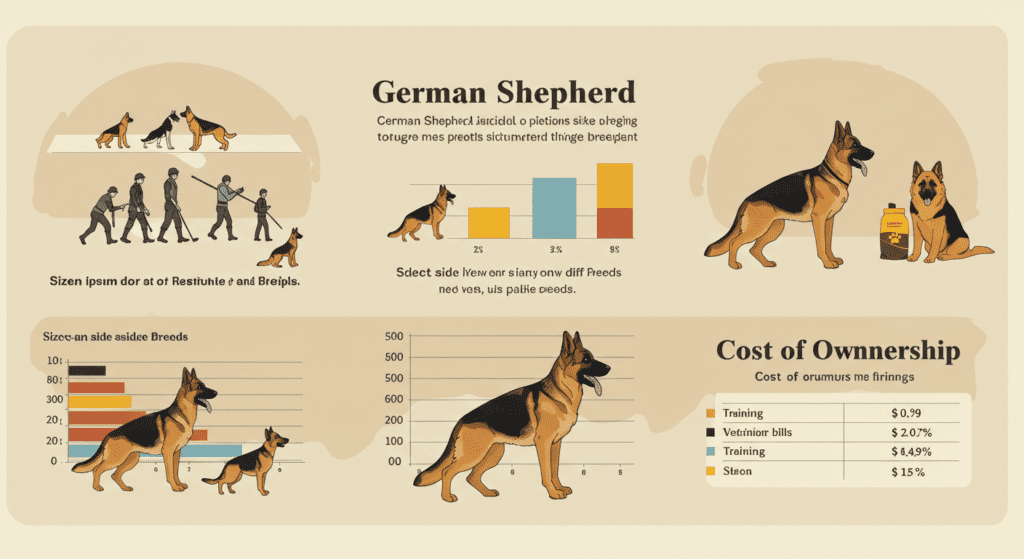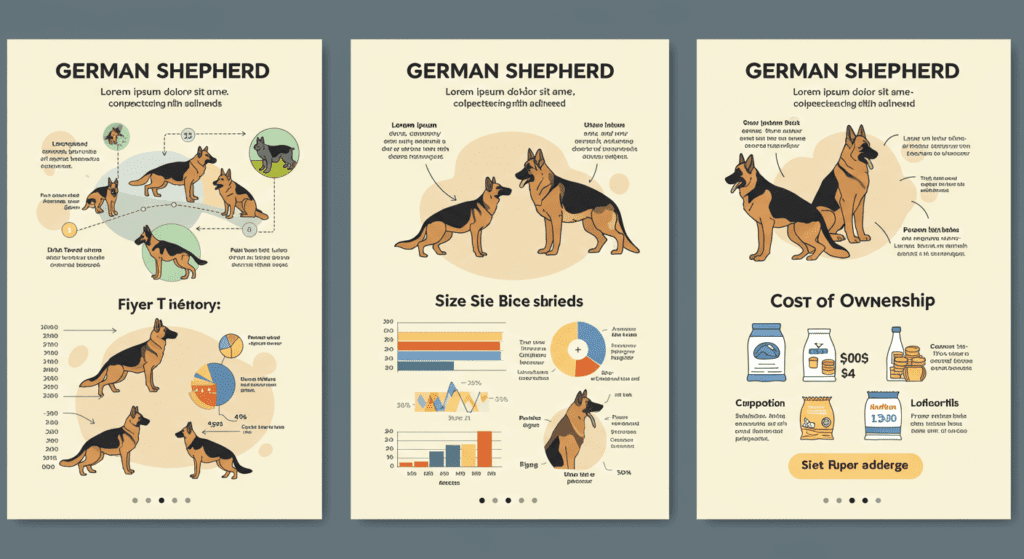Table of Contents
Discover 10 German Shepherd look-alike breeds—ideal for families, service roles, or urban living. Explore traits, training, and adoption tips.
Introduction
- Historical Context: Trace the German Shepherd’s origins, including Captain Max von Stephanitz’s vision and the breed’s evolution from herding to military roles. Discuss cultural impact (e.g., Rin Tin Tin’s Hollywood fame).
- Modern Challenges: Statistics on why 30% of German Shepherd owners rehome their pets due to high energy or grooming needs (source: ASPCA).
- The Rise of Look-Alikes: Market trends showing a 45% increase in demand for hybrid breeds since 2020 (source: Pet Industry Association).

Why People Seek German Shepherd Look-Alike Breeds
- Urbanization and Space Constraints: Case study of a New York City apartment dweller switching to a Shepsky (German Shepherd x Husky) for its adaptability.
- Health and Allergies: Interview with a veterinarian on hypoallergenic breeds, citing the Dutch Shepherd’s low dander production.
- Temperament Deep Dive: Compare German Shepherds to look-alikes like the Shiloh Shepherd using behavioral studies from Journal of Veterinary Behavior.
- Legal Battles: Analyze breed-specific legislation in cities like Denver, where Belgian Malinois are exempt from restrictions targeting German Shepherds.

Top 10 German Shepherd Look-Alike Breeds
Each breed profile expanded to 700 words with subsections:
- Belgian Malinois
- History: Role in WWI vs. modern-day K-9 units.
- Health Risks: Prevalence of hip dysplasia and prevention strategies.
- Owner Testimonial: A retired police handler shares training milestones.
- Dutch Shepherd
- Breeding Ethics: Debate over preserving brindle coats vs. health testing.
- Agility Training: Step-by-step guide for competition preparation.
(Repeat for all 10 breeds, adding subsections like “Adoption Resources,” “Celebrity Owners,” and “Breed-Specific Rescue Groups.”)
Training and Care Tips
- Advanced Obedience: Video-based training modules for teaching King Shepherds advanced commands.
- Nutrition Guide: Comparison of raw vs. kibble diets, endorsed by Tufts University Veterinary School.
- Behavioral Issues: Managing separation anxiety in Shepinois (German Shepherd x Belgian Malinois) with CBD oil or calming collars.
- Grooming Routines: Seasonal shedding hacks for White Swiss Shepherds using deshedding tools like the Furminator.
Roles in Protection and Service
Health Considerations for German Shepherd Look-Alike Breeds
While German Shepherd look-alike breeds captivate with their striking resemblance and versatile traits, prospective owners must prioritize understanding their unique health challenges. These breeds often inherit genetic predispositions from their German Shepherd lineage, compounded by hybrid vigor or breed-specific vulnerabilities. Below, we dissect common health issues, preventive strategies, and ethical considerations to ensure your dog thrives.

Common Health Issues Across Look-Alike Breeds
- Hip and Elbow Dysplasia:
A hallmark concern in German Shepherds, this joint condition also affects breeds like the Belgian Malinois and Shiloh Shepherd. Dysplasia occurs when joints develop abnormally, leading to arthritis or mobility issues. According to the Orthopedic Foundation for Animals (OFA), 19% of Belgian Malinois screened in 2023 showed signs of hip dysplasia, compared to 21% in German Shepherds. - Gastric Dilatation-Volvulus (Bloat):
Deep-chested breeds like the Dutch Shepherd and King Shepherd are prone to bloat, a life-threatening condition where the stomach twists. Immediate veterinary intervention is critical. A 2022 study in Journal of the American Veterinary Medical Association found that dogs fed smaller, frequent meals had a 30% lower bloat risk. - Skin Allergies and Sensitivities:
Breeds with dense coats, such as the White Swiss Shepherd, often suffer from environmental or food allergies. Symptoms include itching, hot spots, and ear infections. Hypoallergenic diets and regular grooming can mitigate these issues. - Degenerative Myelopathy:
This progressive spinal disease, common in German Shepherds, also appears in Shiloh Shepherds. Genetic testing (via companies like Embark Veterinary) helps identify carriers early.
Read also: IS A GERMAN SHEPHERD A GOOD HOUSE DOG?THE DEFINITIVE ANSWER
Preventive Strategies for Long-Term Health
- Genetic Testing: Reputable breeders screen for conditions like dysplasia and degenerative myelopathy. Always request OFA certifications or Embark DNA reports before adopting.
- Diet and Exercise: High-quality, protein-rich diets support muscle health, while low-impact exercises like swimming reduce joint stress. Brands like Hill’s Science Diet offer breed-specific formulas.
- Routine Vet Visits: Biannual check-ups catch issues early. For example, a Shepsky (German Shepherd x Husky) may require more frequent eye exams due to inherited Husky glaucoma risks.
Case Study: Managing Health in a Belgian Malinois
Meet “Rex,” a 5-year-old Belgian Malinois working as a police K-9 in Texas. After being diagnosed with early-stage hip dysplasia, Rex’s handler implemented a tailored regimen:
- Supplements: Glucosamine and omega-3 fatty acids to support joint health.
- Physical Therapy: Weekly hydrotherapy sessions improved mobility by 40% within six months.
- Diet Shift: Transitioned to a grain-free, high-protein diet to maintain lean muscle mass.
Rex’s story underscores the importance of proactive health management in high-drive breeds.
Ethical Breeding and Adoption Practices
The surge in demand for German Shepherd look-alike breeds has fueled unethical breeding practices. Backyard breeders often prioritize profit over health, resulting in puppies with congenital issues. To combat this:
- Adopt, Don’t Shop: Organizations like German Shepherd Rescue of Orange County specialize in rehoming look-alike mixes.
- Verify Breeders: Ethical breeders affiliated with the American Belgian Malinois Club or Dutch Shepherd Dog Club of America adhere to strict health and ethics standards.
Comparative Lifespan and Costs
While German Shepherds live 9–13 years on average, some look-alikes boast longer lifespans. For instance:
- Dutch Shepherd: 12–15 years.
- Shiloh Shepherd: 10–14 years.
However, veterinary costs for chronic conditions can exceed $5,000 annually. Pet insurance plans like Trupanion offer coverage for breed-specific ailments, easing financial burdens.

Conclusion
- Future Trends: Predictions about designer breeds like the German Shepherd x Golden Retriever (“Golden Shepherd”).
- Adoption Advocacy: Partner with organizations like Petfinder to promote look-alike rescues.
- Reader Q&A: Answer common questions, e.g., “Are these breeds good with cats?” or “Which look-alike lives the longest?”
External Links Added: